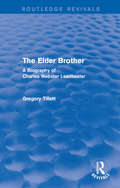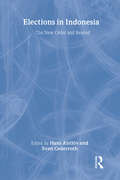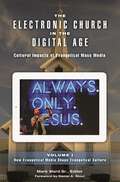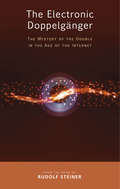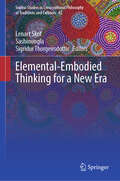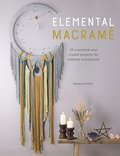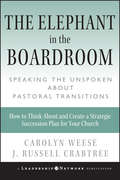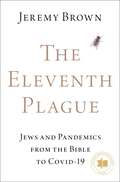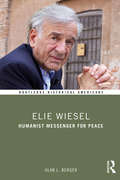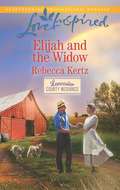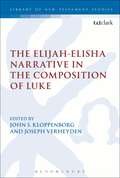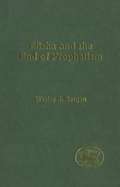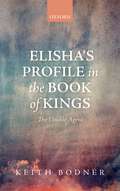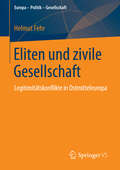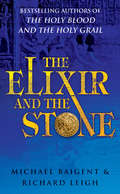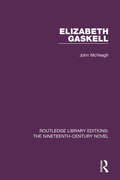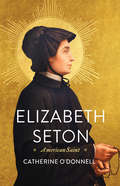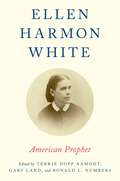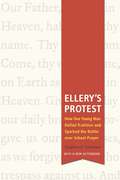- Table View
- List View
The Elder Brother: A Biography of Charles Webster Leadbeater (Routledge Revivals)
by Gregory TillettA leading figure in the Theosophical Society, Leadbeater was a prolific author, writing on subjects ranging from Buddhism, Masonic history and the origins of Christianity through to the power of thought and the fourth dimension. Leadbeater was also the force behind Annie Besant, the discoverer and educator if Krishnamurti, and became Presiding Bishop of the Liberal Catholic Church. For all his influence Charles Leadbeater remains largely unknown as a man. This biography, first published in 1982, dispels many of the mysteries surrounding his life, and Leadbeater emerges as neither evil degenerate or infallible saint, but as a complex and eccentric adventurer into the realm of the occult. This title will be of particular interest to students of history and theology.
The Elder Brother: A Biography of Charles Webster Leadbeater (Routledge Revivals)
by Gregory TillettA leading figure in the Theosophical Society, Leadbeater was a prolific author, writing on subjects ranging from Buddhism, Masonic history and the origins of Christianity through to the power of thought and the fourth dimension. Leadbeater was also the force behind Annie Besant, the discoverer and educator if Krishnamurti, and became Presiding Bishop of the Liberal Catholic Church. For all his influence Charles Leadbeater remains largely unknown as a man. This biography, first published in 1982, dispels many of the mysteries surrounding his life, and Leadbeater emerges as neither evil degenerate or infallible saint, but as a complex and eccentric adventurer into the realm of the occult. This title will be of particular interest to students of history and theology.
Elections in Indonesia: The New Order and Beyond
by Hans Antlov Sven CederrothIt has sometimes been argued that many Indonesians had little sympathy with western notions of elections being events for the contesting and transfer of power and that they rather supported the New Order's use of 'festivals of democracy', elections as occasions at which the mass of ordinary Indonesians were given the opportunity to celebrate the country's achievements under the rule of its New Order leadership as well as legitimize the continued rule of these leaders. But the need to stage-manage these 'elections' as New Order triumphs finally undid the regime. With chapters describing the last New Order election and the first free election in the post-Suharto era, this volume makes an important contribution to our understanding of the demise of the New Order, and the directions being taken by the emerging regime.
Elections in Indonesia: The New Order and Beyond
by Hans Antlöv and Sven CederrothIt has sometimes been argued that many Indonesians had little sympathy with western notions of elections being events for the contesting and transfer of power and that they rather supported the New Order's use of 'festivals of democracy', elections as occasions at which the mass of ordinary Indonesians were given the opportunity to celebrate the country's achievements under the rule of its New Order leadership as well as legitimize the continued rule of these leaders. But the need to stage-manage these 'elections' as New Order triumphs finally undid the regime. With chapters describing the last New Order election and the first free election in the post-Suharto era, this volume makes an important contribution to our understanding of the demise of the New Order, and the directions being taken by the emerging regime.
The Electronic Church in the Digital Age [2 volumes]: Cultural Impacts of Evangelical Mass Media [2 volumes]
by Mark WardThis two-volume set investigates the evangelical presence in America as experienced through digital media, examining current evangelical ideologies regarding education, politics, family, and government.Evangelical broadcasting has greatly expanded its footprint in the digital age. This informative text acquaints readers with how the electronic church of today spreads its message through Internet podcasts, social networking, religious radio programs, and televised sermons; how mass media forms the institution's modern identity; and what the future of the industry holds as mobile church apps, Christian-based video games, and online worship become the norm.The work—split into two volumes—reveals the ways that the Christian broadcast community affects evangelical traditions and influences American society in general. Volume 1 explores how electronic media shapes today's Christian subculture, while the second volume describes how the electronic church impacts the wider American culture, analyzing what key figures in evangelical mass media are saying about today's religious, political, economic, and social issues. The set concludes by addressing criticism about religious media and the prospects of American public discourse to accomodate both secular and religious voices.
The Electronic Church in the Digital Age [2 volumes]: Cultural Impacts of Evangelical Mass Media [2 volumes]
by Mark WardThis two-volume set investigates the evangelical presence in America as experienced through digital media, examining current evangelical ideologies regarding education, politics, family, and government.Evangelical broadcasting has greatly expanded its footprint in the digital age. This informative text acquaints readers with how the electronic church of today spreads its message through Internet podcasts, social networking, religious radio programs, and televised sermons; how mass media forms the institution's modern identity; and what the future of the industry holds as mobile church apps, Christian-based video games, and online worship become the norm.The work—split into two volumes—reveals the ways that the Christian broadcast community affects evangelical traditions and influences American society in general. Volume 1 explores how electronic media shapes today's Christian subculture, while the second volume describes how the electronic church impacts the wider American culture, analyzing what key figures in evangelical mass media are saying about today's religious, political, economic, and social issues. The set concludes by addressing criticism about religious media and the prospects of American public discourse to accomodate both secular and religious voices.
The Electronic Doppelganger: The Mystery of the Double in the Age of the Internet
by Rudolf Steiner'Large temptations will emanate from these machine-animals, produced by people themselves, and it will be the task of a spiritual science that explores the cosmos to ensure all these temptations do not exert any damaging influence on human beings.'In an increasingly digitised world, where both work and play are more and more taking place online and via screens, Rudolf Steiner's dramatic statements from 1917 appear prophetic. Speaking of 'intelligent machines' that would appear in the future, Steiner presents a broad context that illustrates the multitude of challenges human beings will face. If humanity and the Earth are to continue to evolve together with the cosmos, and not be cut off from it entirely, we will need to work consciously and spiritually to create a counterweight to such phenomena.In the lectures gathered here, edited with commentary and notes by Andreas Neider, Rudolf Steiner addresses a topic that he was never to speak of again: the secret of the 'geographical' or the 'ahrimanic' doppelganger. The human nervous system houses an entity that does not belong to its constitution, he states. This is an ahrimanic being which enters the body shortly before birth and leaves at death, providing the basis for all electrical currents that are needed to process and coordinate sense perceptions and react to them.Based on his spiritual research, Rudolf Steiner discusses this doppelganger or 'double' in the wider context of historic occult events relating to 'spirits of darkness'. Specific brotherhoods seek to keep such knowledge to themselves in order to exert power and spread materialism. But this knowledge is critical, says Steiner, if the geographical doppelganger and its challenges are to be understood.
Elemental-Embodied Thinking for a New Era (Sophia Studies in Cross-cultural Philosophy of Traditions and Cultures #42)
by Lenart Škof Sigridur Thorgeirsdottir SashinunglaThis collection responds to widespread, complex, and current environmental challenges by presenting eleven original essays on a new elemental-embodied approach in environmental humanities. This approach has a special focus on elemental and indigenous philosophies as well as localized experiences of terrestrial forces: from earthquakes and eruptions to pandemics and natural disasters. Representing a shift in modern Western scientific and disembodied thinking of nature, this edited book approaches the question of relationality and intertwining of human and natural being by utilizing the elemental-embodied methodologies within philosophy of embodiment and nature. Supported by research in cognitive sciences, the contributors represent the experiential and affective turn within research into human cognition. As embodied, the human being is embedded and interacting with all there is. The aim of this edited volume is to indicate new paths toward regaining our access to natural being within usand thus toward reconnecting with the natural environment and the things and beings around us in a new, environmentally enhanced way. It appeals to researchers and students working in many fields, predominantly in philosophy, as well as religious and environmental studies.
Elemental Macramé: 20 macramé and crystal projects for balance and beauty
by Rebecca MillarCreate beautiful macramé projects that invoke the sacred elements of Earth, Air, Water, Fire and Spirit. The idea of classical ‘elements’ is common to many belief systems including Ancient Greek, Egyptian, Babylonian, Hinduism and Buddhism, as well as Chinese and Japanese philosophies. The five elements of the Pagan religion Wicca represent the five points of the pentagram, a powerful sacred symbol. No matter what your beliefs, paying attention to the forces of nature can bring a greater sense of spirituality and calm to your life, which is equally true of the craft of macramé, which like all handicrafts has proven benefits for wellbeing. This unique and beautiful book celebrates each of the Earth's sacred elements with projects that even beginners to macramé can tackle with ease. In nature, each element has its own specific properties, colours and stones associated with it, which these projects incorporate to dramatic effect. The 20 projects include dreamcatchers, wall hangings, home accessories and jewellery, which all draw their inspiration from nature and the elements. Many of the projects have crystals incorporated into them, for the good vibrations and healing energy they bring. You'll also learn how to dip-dye macrame for wonderful ombre effects and work with a variety of different coloured cords to bring beauty and interest to your pieces. Make a tree of life hoop to connect with the earth, a dreamcatcher to protect you during sleep, a hanging fruit bowl to feed and nourish you, and a plant hanger to purify your air. Make a necklace to bring out your inner goddess, a crystal suncatcher to capture your fire, or some coasters for your altar candles to sit on. With 20 projects to choose from you will find a whole host of ways to enjoy macramé in a new intentional, spiritual light. Author Rebecca Millar is best known as the creator of Vanir Creations, who has amassed a huge online following for her dreamy macramé hoops and moon catchers. Entirely self-taught, Rebecca now generously shares her secrets in this book, which demystifies the craft with simple explanations of the knots and techniques required.
The Elephant in the Boardroom: Speaking the Unspoken about Pastoral Transitions (Jossey-Bass Leadership Network Series #12)
by Carolyn Weese J. Russell CrabtreeCarolyn Weese and J. Russell Crabtree—experts in the field of church leadership—have written a nuts-and-bolts guide to developing a succession plan for smoothing pastoral transitions. Filled with strategies and solid advice, this handy resource is based in solid research and the authors’ many years of experience working with churches in a wide variety of denominations. Weese and Crabtree clearly show that leadership succession should be part of every church’s planning process.
The Eleventh Plague: Jews, Plagues, and Pandemics from the Bible to COVID-19
by Jeremy BrownA physician and historian of science and medicine at the National Institute of Health tells the hidden story of how plagues and pandemics shaped the history of the Jewish people. Plagues, pandemics, and infectious diseases have shaped the history of the Jewish people. Of course, there were the ten biblical plagues that famously smote the Egyptians--from the rain of frogs to the deaths of the firstborn--but that is just the start of the story. For the Talmudic Sages infectious diseases were part of the fundamental fabric of God's created world. In later times, however, disease was often thought to be caused by malign spells and incantations. A counter-magic developed to combat them. Amulets were deployed and miracle workers sought out. Surprisingly, Jeremy Brown shows, Jews sometimes even visited Christian shrines and beseeched the intervention of their saints. In 1348, when the Black Death swept through Europe, Jews fell victim both to the disease, for which they were blamed, and to the anti-Semitic violence that followed. At least 235 Jewish communities were persecuted even as Pope Clement IV ruled that anyone joining or authorizing the persecution would be excommunicated. In The Eleventh Plague, Brown investigates the relation between Judaism and infectious diseases throughout the ages, from premodern and early-modern plagues, to rabbinic responses to smallpox and cholera, to the special vulnerabilities Jewish immigrants faced in the US as result of prejudice, and to the curious practice of "Black Weddings" in which two orphans are married in a cemetery. Popularized during the 1918 influenza pandemic the practice was revived in response to the Covid-19 pandemic, showing that the intriguing relationship between Judaism and infectious disease remains relevant today.
The Eleventh Plague: Jews, Plagues, and Pandemics from the Bible to COVID-19
by Jeremy BrownA physician and historian of science and medicine at the National Institute of Health tells the hidden story of how plagues and pandemics shaped the history of the Jewish people. Plagues, pandemics, and infectious diseases have shaped the history of the Jewish people. Of course, there were the ten biblical plagues that famously smote the Egyptians--from the rain of frogs to the deaths of the firstborn--but that is just the start of the story. For the Talmudic Sages infectious diseases were part of the fundamental fabric of God's created world. In later times, however, disease was often thought to be caused by malign spells and incantations. A counter-magic developed to combat them. Amulets were deployed and miracle workers sought out. Surprisingly, Jeremy Brown shows, Jews sometimes even visited Christian shrines and beseeched the intervention of their saints. In 1348, when the Black Death swept through Europe, Jews fell victim both to the disease, for which they were blamed, and to the anti-Semitic violence that followed. At least 235 Jewish communities were persecuted even as Pope Clement IV ruled that anyone joining or authorizing the persecution would be excommunicated. In The Eleventh Plague, Brown investigates the relation between Judaism and infectious diseases throughout the ages, from premodern and early-modern plagues, to rabbinic responses to smallpox and cholera, to the special vulnerabilities Jewish immigrants faced in the US as result of prejudice, and to the curious practice of "Black Weddings" in which two orphans are married in a cemetery. Popularized during the 1918 influenza pandemic the practice was revived in response to the Covid-19 pandemic, showing that the intriguing relationship between Judaism and infectious disease remains relevant today.
Elie Wiesel: Humanist Messenger for Peace (Routledge Historical Americans)
by Alan L. BergerElie Wiesel: Humanist Messenger for Peace is part biography and part moral history of the intellectual and spiritual journey of Elie Wiesel, a Holocaust survivor, human rights activist, author, university professor, and Nobel Peace Prize winner. In this concise text, Alan L. Berger portrays Wiesel’s transformation from a pre-Holocaust, deeply God-fearing youth to a survivor of the Shoah who was left with questions for both God and man. An advisor to American presidents of both political parties, his nearly 60 books voiced an activism on behalf of oppressed people everywhere. The book illuminates Wiesel’s contributions in the areas of religion, human rights, literature, and Jewish thought to show the impact that he has had on American life. Supported by primary documents about and from Wiesel, the volume gives students a gateway to explore Wiesel’s incredible life. This book will make a great addition to courses on American religious or intellectual thought.
Elie Wiesel: Humanist Messenger for Peace (Routledge Historical Americans)
by Alan L. BergerElie Wiesel: Humanist Messenger for Peace is part biography and part moral history of the intellectual and spiritual journey of Elie Wiesel, a Holocaust survivor, human rights activist, author, university professor, and Nobel Peace Prize winner. In this concise text, Alan L. Berger portrays Wiesel’s transformation from a pre-Holocaust, deeply God-fearing youth to a survivor of the Shoah who was left with questions for both God and man. An advisor to American presidents of both political parties, his nearly 60 books voiced an activism on behalf of oppressed people everywhere. The book illuminates Wiesel’s contributions in the areas of religion, human rights, literature, and Jewish thought to show the impact that he has had on American life. Supported by primary documents about and from Wiesel, the volume gives students a gateway to explore Wiesel’s incredible life. This book will make a great addition to courses on American religious or intellectual thought.
Elijah And The Widow: Elijah And The Widow Coming Home To Texas Falling For The Millionaire (Lancaster County Weddings #4)
by Rebecca KertzThe Widow's Second Chance
The Elijah-Elisha Narrative in the Composition of Luke (The Library of New Testament Studies #493)
by John S. Kloppenborg Joseph VerheydenThis collection examines the allusions to the Elijah- Elisha narrative in the gospel of Luke. The volume presents the case for a "maximalist†? view, which holds that the Elijah-Elisha narrative had a dominant role in the composition of Luke 7 and 9, put forward by Thomas L. Brodie and John Shelton, with critical responses to this thesis by Robert Derrenbacker, Alex Damm, F. Gerald Downing, David Peabody, Dennis MacDonald and Joseph Verheyden.Taken together the contributions to this volume provide fascinating insights into the composition of the gospel of Luke, and the editorial processes involved in its creation. Contributions cover different approaches to the text, including issues of intertextuality and rhetorical-critical examinations. The distinguished contributors and fast-paced debate make this book an indispensable addition to any theological library.
Elisha and the End of Prophetism (The Library of Hebrew Bible/Old Testament Studies)
by Wesley J. BergenThe stories of Elisha the prophet have received scant attention in recent years, perhaps because they are so enigmatic. This study places the Elisha material firmly within the narrative of Genesis-2 Kings, and examines the effect these stories have on the reader's perception of the role of the 'prophet'. Using the narratological theories of Mieke Bal, David Jobling and others, Bergen shows that the Elisha stories present prophetism in a negative light, confining prophets to a rather limited scope of action in the narrative world.
Elisha's Profile In The Book Of Kings: The Double Agent
by Keith BodnerElisha's Profile in the Book of Kings uses the tools of literary criticism to read the Elisha narrative as an integral component of the Deuteronomistic History compiled in the aftermath of the Babylonian invasion and destruction of Jerusalem in 586 BCE. From his investiture in 1 Kings 19 to his final cameo in 2 Kings 13, Elisha the prophet has one of the most extensively-narrated careers in Israel's royal history. During a particularly dark and contested era where the corrupt northern kings hold sway, Elisha enters the ideological battleground and boldly raises his voice and performs remarkable signs to stem the tide of injustice and religious inconstancy. Empowered by a double portion of his master Elijah's spirit, Elisha is a double agent who continues the task of dismantling the Omride dynasty. Moving between the international stage and more domestic locales, Elisha travels widely and interacts with a host of characters from virtually every socio-economic category, visiting foreign capitals and cities under siege as well as wealthy homes and obscure villages. With actions that range from feeding a multitude to mind-reading and raising the dead, Elisha's performance eclipses that of his master and ensures a lasting place in ancient Israel's prophetic heritage.
Eliten und zivile Gesellschaft: Legitimitätskonflikte in Ostmitteleuropa (Europa – Politik – Gesellschaft)
by Helmut FehrIn dieser Studie werden Eliten in Ostmitteleuropa unter vergleichenden Gesichtspunkten untersucht. Das Spektrum der Eliten reicht von den kommunistischen Führungsgruppen bis zu neuen Machteliten und Gegeneliten, der Untersuchungszeitraum von 1968 bis 2013. Auf breiter empirischer Basis (ausführliche Interviews, Dokumente, Printmedien) beleuchtet der Autor den Elitenwandel in Polen, der Tschechischen Republik und der DDR/Ostdeutschland. Dabei geht es um ein tieferes Verständnis der Demokratisierung, der Elitenbildung und der Legitimitätskonflikte vor und nach den revolutionären Umbrüchen von 1989.
The Elixir And The Stone: The Tradition of Magic and Alchemy
by Michael Baigent Richard LeighSince the seventeenth century, science has been contending with philosophy, organised religion and the arts for domination over Western civilisation and society. By the middle of the twentieth century, the battle appeared to be won; scientific rationalism and scepticism were triumphant. Yet in the last few decades a strong and potent counter-current has emerged. One manifestation of this has been the so-called occult revival. In the Elixir and the Stone, Baigent and Leigh argue that this occult revival - and indeed the entire revolution in attitudes which has taken place recently - owes a profound debt to Hermeticism, a body of esoteric teaching which flourished in Alexandria two thousand years ago and which then went underground. The authors trace the history of this intriguing and all-encompassing philosophy - which has much in common with contemporary holistic thought - charting its origin in the Egyptian mysteries, and demonstrating how it continued to exercise enormous influence through the magicians and magi of the Middle Ages and the Renaissance. Many remarkable characters feature in the narrative, including the Franciscan friar Roger Bacon and the Elizabethan magus John Dee; prototype of Shakespeare's Prospero in The Tempest, but he central figure that emerges is that of Faust himself - one of the defining myths of Western civilisation. The Elixir and the Stone is a remarkably rich and ambitious book that adds up to a little short of an alternative history of the intellectual world. Perhaps for the first time it puts into their true context those shadowy alchemists and magicians who have haunted the imaginations of people for centuries. Moreover it offers a way of looking at the world that is in one sense 'alternative', but, in another, deeply historical.
Elizabeth Gaskell (Routledge Library Editions: The Nineteenth-Century Novel)
by John McVeaghFirst published in 1970, this study demonstrates both the range and essential unity of the works of Mrs. Gaskell. The author analyses the novels of social criticism, the biography of Charlotte Brontë and the novels of country life as distinct expressions of her genius, commenting on recurrent themes, typical methods of presentation and consistent attitudes as they appear in each of the works. The differences of subject and intention between the three kinds of writing will be seen in the extracts which indicate the range of her ability and interests. The final section summarises her range and success and failure. This book will be of interest to students of literature and sociological history.
Elizabeth Gaskell (Routledge Library Editions: The Nineteenth-Century Novel)
by John McVeaghFirst published in 1970, this study demonstrates both the range and essential unity of the works of Mrs. Gaskell. The author analyses the novels of social criticism, the biography of Charlotte Brontë and the novels of country life as distinct expressions of her genius, commenting on recurrent themes, typical methods of presentation and consistent attitudes as they appear in each of the works. The differences of subject and intention between the three kinds of writing will be seen in the extracts which indicate the range of her ability and interests. The final section summarises her range and success and failure. This book will be of interest to students of literature and sociological history.
Elizabeth Seton: American Saint
by Catherine O'DonnellIn 1975, two centuries after her birth, Pope Paul VI canonized Elizabeth Ann Seton, making her the first saint to be a native-born citizen of the United States in the Roman Catholic Church. Seton came of age in Manhattan as the city and her family struggled to rebuild themselves after the Revolution, explored both contemporary philosophy and Christianity, converted to Catholicism from her native Episcopalian faith, and built the St. Joseph’s Academy and Free School in Emmitsburg, Maryland. Hers was an exemplary early American life of struggle, ambition, questioning, and faith, and in this flowing biography, Catherine O’Donnell has given Seton her due.O’Donnell places Seton squarely in the context of the dynamic and risky years of the American and French Revolutions and their aftermath. Just as Seton’s dramatic life was studded with hardship, achievement, and grief so were the social, economic, political, and religious scenes of the Early American Republic in which she lived. O’Donnell provides the reader with a strong sense of this remarkable woman’s intelligence and compassion as she withstood her husband’s financial failures and untimely death, undertook a slow conversion to Catholicism, and struggled to reconcile her single-minded faith with her respect for others’ different choices. The fruit of her labors were the creation of a spirituality that embraced human connections as well as divine love and the American Sisters of Charity, part of an enduring global community with a specific apostolate for teaching.The trove of correspondence, journals, reflections, and community records that O’Donnell weaves together throughout Elizabeth Seton provides deep insight into her life and her world. Each source enriches our understanding of women’s friendships and choices, illuminates the relationships within the often-opaque world of early religious communities, and upends conventional wisdom about the ways Americans of different faiths competed and collaborated during the nation’s earliest years. Through her close and sympathetic reading of Seton’s letters and journals, O’Donnell reveals Seton the person and shows us how, with both pride and humility, she came to understand her own importance as Mother Seton in the years before her death in 1821.
Ellen Harmon White: American Prophet
In America, as in Britain, the Victorian era enjoyed a long life, stretching from the 1830s to the 1910s. It marked the transition from a pre-modern to a modern way of life. Ellen Harmon White's life (1827-1915) spanned those years and then some, but the last three months of a single year, 1844, served as the pivot for everything else. When the Lord failed to return on October 22, as she and other followers of William Miller had predicted, White did not lose heart. Fired by a vision she experienced, White played the principal role in transforming a remnant minority of Millerites into the sturdy sect that soon came to be known as the Seventh-day Adventists. She and a small group of fellow believers emphasized a Saturday Sabbath and an imminent Advent. Today that flourishing denomination posts eighteen million adherents globally and one of the largest education, hospital, publishing, and missionary outreach programs in the world. Over the course of her life White generated 70,000 manuscript pages and letters, and produced 40 books that have enjoyed extremely wide circulation. She ranks as one of the most gifted and influential religious leaders in American history and this volume tells her story in a new and remarkably informative way. Some of the contributors identify with the Adventist tradition, some with other Christian denominations, and some with no religious tradition at all. Their essays call for White to be seen as a significant figure in American religious history and for her to be understood within the context of her times.
Ellery's Protest: How One Young Man Defied Tradition and Sparked the Battle over School Prayer
by Stephen D. Solomon“Solomon’s fascinating and sweeping history of the legal fight over mandatory school prayers is compelling, judicious, and elegantly written. Fabulous!” —David Rudenstine, Dean, Benjamin N. Cardozo School of Law, Yeshiva University “Stephen Solomon’s Ellery’s Protest provides a brilliant analysis of a major Supreme Court decision that redefined the relationship between church and state almost a half century ago. This study goes well beyond simply offering a gripping account of the course of litigation that brought before the Justices the contentious issue of prayer and Bible reading in public schools, though the thoroughness of that account would merit careful reading by itself. Especially impressive is the author’s deep probing of hitherto neglected sources, and invaluable primary material including extensive direct contact with the plaintiff, the ‘Ellery’ of the book’s title. Finally, and perhaps most impressive, is Solomon’s careful placement of the issue and the case in a far broader context that is as critical to national life and policy today as it was four and a half decades ago when the high Court first tackled these questions.” —Robert O’Neil, Professor of Law, University of Virginia Great legal decisions often result from the heroic actions of average citizens. Ellery’s Protest is the story of how one student’s objection to mandatory school prayer and Bible reading led to one of the most controversial court cases of the twentieth century—and a decision that still reverberates in the battle over the role of religion in public life. Abington School District v. Schempp began its journey through the nation’s courts in 1956, when sixteen-year-old Ellery Schempp protested his public school’s compulsory prayer and Bible-reading period by reading silently from the Koran. Ejected from class for his actions, Schempp sued the school district. The Supreme Court’s decision in his favor was one of the most important rulings on religious freedom in our nation’s history. It prompted a conservative backlash that continues to this day, in the skirmishes over school prayer, the teaching of creationism and intelligent design, and the recitation of the Pledge of Allegiance with the phrase “under God.” Author Stephen D. Solomon tells the fascinating personal and legal drama of the Schempp case: the family’s struggle against the ugly reactions of neighbors, and the impassioned courtroom clashes as brilliant lawyers on both sides argued about the meaning of religious freedom. But Schempp was not the only case challenging religious exercises in the schools at the time, and Ellery’s Protest describes the race to the Supreme Court among the attorneys for four such cases, including one involving the colorful atheist Madalyn Murray. Solomon also explores the political, cultural, and religious roots of the controversy. Contrary to popular belief, liberal justices did not kick God out of the public schools. Bitter conflict over school Bible reading had long divided Protestants and Catholics in the United States. Eventually, it was the American people themselves who removed most religious exercises from public education as a more religiously diverse nation chose tolerance over sectarianism. Ellery’s Protest offers a vivid account of the case that embodied this change, and a reminder that conservative justices of the 1950s and 60s not only signed on to the Schempp decision, but strongly endorsed the separation of church and state.
